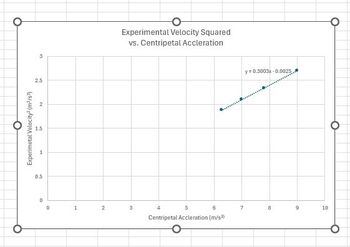
Physics for Scientists and Engineers: Foundations and Connections
1st Edition
ISBN: 9781133939146
Author: Katz, Debora M.
Publisher: Cengage Learning
expand_more
expand_more
format_list_bulleted
Question
Explain how centripetal acceleration is affected when the hanging mass changes. Does the graph verify the relationship in equation r = x i + y j = r cosθi + r sinθj?

Transcribed Image Text:Data Table 5: Calculations: Centripetal Acceleration-Varying the Hanging Mass, M
Hanging
Trial
Mass
(changes)
Radius
(stays the
same)
Experimental
Velocity
Centripetal
Acceleration
VE²
v
r
1
0.02431 kg
0.30 m
1.37 m/s
1.88 m²/s²
6.27 m/s²
2
0.04862 kg
0.30 m
1.45 m/s
2.10 m²/s²
7.0 m/s²
3
0.07293 kg
0.30 m
1.53 m/s
2.34 m²/s²
7.8 m/s²
4
0.09724 kg
0.30 m
1.64 m/s
2.70 m²/s²
9.0 m/s²

Transcribed Image Text:3
Experimental Velocity Squared
vs. Centripetal Accleration
Experimetal Velocity² (m²/s²)
1
1.5
2
2.5
in
0.5
0
0
1
2
3
4
y=0.3003x-0.0025.
6
7
8
10
5
Centripetal Accleration (m/s²)
о
Expert Solution
This question has been solved!
Explore an expertly crafted, step-by-step solution for a thorough understanding of key concepts.
Step by stepSolved in 2 steps

Knowledge Booster
Similar questions
- When Sedna was discovered in 2003, it was the most distant object known to orbit the Sun. Currently, it is moving toward the inner solar system. Its period is 10,500 years. Its perihelion distance is 75 AU. a. What is its semimajor axis in astronomical units? b. What is its aphelion distance?arrow_forwardSince 1995, hundreds of extrasolar planets have been discovered. There is the exciting possibility that there is life on one or more of these planets. To support life similar to that on the Earth, the planet must have liquid water. For an Earth-like planet orbiting a star like the Sun, this requirement means that the planet must be within a habitable zone of 0.9 AU to 1.4 AU from the star. The semimajor axis of an extrasolar planet is inferred from its period. What range in periods corresponds to the habitable zone for an Earth-like Planet orbiting a Sun-like star?arrow_forwardWhat, on a sphere, is analogous to a two-dimensional Cartesian coordinate system?arrow_forward
- (a) What is the approximate force of gravity on a 70kg person due to the Andromeda galaxy, assuming its total mass is 1013 than of our Sun and acts like a single mass 2 Mly away? (b) What is the ratio of this force to the person's weight? Note that Andromeda is the closest large galaxy.arrow_forwardA neutron star is a cold, collapsed star with nuclear density. A particular neutron star has a mass twice that of our Sun with a radius of 12.0 km. (a) What would be the weight of a 100-kg astronaut on standing on its surface? (b) What does this tell us about landing on a neutron star?arrow_forwardIn what frame(s) of reference are Kepler's laws valid? Are Kepler's laws purely descriptive, or do they contain causal information?arrow_forward
- We use the terms sunset and sunrise. In what way are these terms misleading?arrow_forwardCalculate the effective gravitational field vector g at Earths surface at the poles and the equator. Take account of the difference in the equatorial (6378 km) and polar (6357 km) radius as well as the centrifugal force. How well does the result agree with the difference calculated with the result g = 9.780356[1 + 0.0052885 sin 2 0.0000059 sin2(2)]m/s2 where is the latitude?arrow_forwardComet Halley (Fig. P11.21) approaches the Sun to within 0.570 AU, and its orbital period is 75.6 yr. (AU is the symbol for astronomical unit, where 1 AU = 1.50 1011 m is the mean EarthSun distance.) How far from the Sun will Halleys comet travel before it starts its return journey?arrow_forward
- Is Earth an inertial frame of reference? Is the Sun? Justify your response.arrow_forwardShow that the velocity of a star orbiting its galaxy in a circular orbit is inversely proportional to the square root of its orbital radius, assuming the mass of the stars inside its orbit acts like a single mass at the center of the galaxy. You may use an equation from a previous chapter to support your conclusion, but you must justify its use and define all terms used.arrow_forward(a) One of the moons of Jupiter, named Io, has an orbital radius of 4.22 108 m and a period of 1.77 days. Assuming the orbit is circular, calculate the mass of Jupiter, (b) The largest moon of Jupiter, named Ganymede, has an orbital radius of 1.07 109 m and a period of 7.16 days. Calculate the mass of Jupiter from this data, (c) Are your results to parts (a) and (b) consistent? Explain.arrow_forward
arrow_back_ios
SEE MORE QUESTIONS
arrow_forward_ios
Recommended textbooks for you
 Physics for Scientists and Engineers: Foundations...PhysicsISBN:9781133939146Author:Katz, Debora M.Publisher:Cengage Learning
Physics for Scientists and Engineers: Foundations...PhysicsISBN:9781133939146Author:Katz, Debora M.Publisher:Cengage Learning Glencoe Physics: Principles and Problems, Student...PhysicsISBN:9780078807213Author:Paul W. ZitzewitzPublisher:Glencoe/McGraw-Hill
Glencoe Physics: Principles and Problems, Student...PhysicsISBN:9780078807213Author:Paul W. ZitzewitzPublisher:Glencoe/McGraw-Hill An Introduction to Physical SciencePhysicsISBN:9781305079137Author:James Shipman, Jerry D. Wilson, Charles A. Higgins, Omar TorresPublisher:Cengage Learning
An Introduction to Physical SciencePhysicsISBN:9781305079137Author:James Shipman, Jerry D. Wilson, Charles A. Higgins, Omar TorresPublisher:Cengage Learning College PhysicsPhysicsISBN:9781938168000Author:Paul Peter Urone, Roger HinrichsPublisher:OpenStax College
College PhysicsPhysicsISBN:9781938168000Author:Paul Peter Urone, Roger HinrichsPublisher:OpenStax College Horizons: Exploring the Universe (MindTap Course ...PhysicsISBN:9781305960961Author:Michael A. Seeds, Dana BackmanPublisher:Cengage Learning
Horizons: Exploring the Universe (MindTap Course ...PhysicsISBN:9781305960961Author:Michael A. Seeds, Dana BackmanPublisher:Cengage Learning Physics for Scientists and Engineers, Technology ...PhysicsISBN:9781305116399Author:Raymond A. Serway, John W. JewettPublisher:Cengage Learning
Physics for Scientists and Engineers, Technology ...PhysicsISBN:9781305116399Author:Raymond A. Serway, John W. JewettPublisher:Cengage Learning

Physics for Scientists and Engineers: Foundations...
Physics
ISBN:9781133939146
Author:Katz, Debora M.
Publisher:Cengage Learning

Glencoe Physics: Principles and Problems, Student...
Physics
ISBN:9780078807213
Author:Paul W. Zitzewitz
Publisher:Glencoe/McGraw-Hill

An Introduction to Physical Science
Physics
ISBN:9781305079137
Author:James Shipman, Jerry D. Wilson, Charles A. Higgins, Omar Torres
Publisher:Cengage Learning

College Physics
Physics
ISBN:9781938168000
Author:Paul Peter Urone, Roger Hinrichs
Publisher:OpenStax College

Horizons: Exploring the Universe (MindTap Course ...
Physics
ISBN:9781305960961
Author:Michael A. Seeds, Dana Backman
Publisher:Cengage Learning

Physics for Scientists and Engineers, Technology ...
Physics
ISBN:9781305116399
Author:Raymond A. Serway, John W. Jewett
Publisher:Cengage Learning